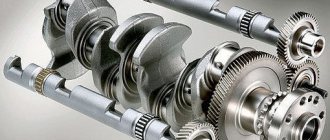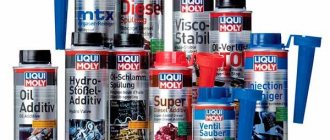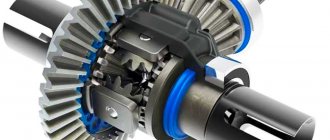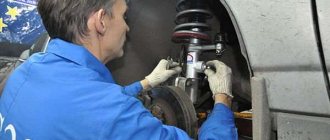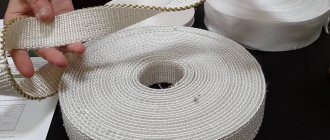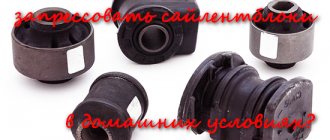Sometimes in a car there is a need to connect parts together not rigidly, using threaded, press or welding fits, but with a certain degree of freedom. In such cases, the connections are called hinged. Hinges can have different designs, depending on the required properties. In particular, with programmed elasticity in all directions of movement of the component parts.
To solve the tasks, silent blocks are used. Where they are installed, what types they are and what their disadvantages are, we will consider below.
Why are silent blocks needed?
Rubber-metal hinges (RMH) are commonly called silent blocks. This name will remind many of you of English lessons at school, when the teacher called the class to order using the word “Silence,” that is, silence.
This most accurately defines the essence of the RMS, its ability to elastically and silently transmit force. For this purpose, rubber or another similar material, for example polyurethane, is used in the hinge.
Where are they installed in the car?
Most often, silent blocks are used in car suspensions. This is where their basic properties are important:
- the ability to twist without collapsing friction between the component parts;
- quiet operation;
- the presence of a relatively large stroke for rotation with a minimum for all other displacements;
- a significant but gradual increase in resistance force when trying to bend the hinge in an undesirable direction;
- long service life provided that high-quality materials are used and normal operation is performed.
Typical applications are:
- hinges for attaching suspension arms to the body or subframes;
- shock absorber installation points;
- anti-roll bars;
- tips of jet rods.
In addition, silent blocks can be used at the mounting points of transmission units. This is done in order to minimize the transmission of vibrations and noise to the body, generally increase comfort in the car and dampen sharp, destructive impacts.
Summarize
- Silent blocks are located not only on the suspension arms, but also on the steering knuckles, stabilizer struts, etc.
- This is a hinge; it can have one bushing inside, or two – inside and outside. According to the type of pressing, there are internal and external.
- They come with a solid rubber insert or with cut out fragments in it.
- Polyurethane fillers are better than rubber fillers.
- To check the rubber-metal hinge, a visual inspection is sufficient. To accurately diagnose silent blocks, we use the “staggering” method. But in any case, if they have cracks, then they need to be replaced.
How the hinge works
The RMS consists of two metal bushings, between which there is an elastic element made of elastic rubber or polyurethane.
In fact, it is an elastically deformable bushing clamped between the clips, but there is one fundamental difference - the rubber of the silent block is glued or vulcanized to the metal of the clips, that is, in a working silent block, displacement of the bushing relative to the metal is excluded.
Friction is eliminated, hence the longer service life of the joint than that of a sleeve simply clamped with metal. Although sometimes bushing assemblies are also called silent blocks, which is not entirely true, but is used in the description of assemblies.
When the hinge is twisted, the rubber is deformed, but if the unit is correctly calculated, its irreversible destruction does not occur. Typically, hinges work specifically for rotation between metal cages, but it also happens to be used for bending.
For example, often the rear silent blocks of the front suspension arms of budget cars have a vertically oriented axis. The normal mode here will be the bending of the hinge, and not rotation.
This is interesting: Why do you need an on-board computer in a car and how does it calculate fuel consumption?
The RMS, installed in the eyes and traverses of fastening transmission units, does not have a clear orientation towards a specific working movement; here it rather acts as an elastic gasket between the massive unit and the body or frame of the car.
Due to the calculated rigidity of the rubber, peak vibration and shock loads can be absorbed in all directions. The hinges in the mounting eyes of telescopic shock absorbers serve approximately the same way, although here there is still a predominant direction of deformation towards rotation.
What is a silent block?
The part is made in the form of a small cylinder consisting of three elements:
- the outer part is made of thin-walled steel and equipped with seating elements - shell and stiffeners;
- core – solid metal sleeve;
- the gap between the outer and inner elements is filled with an elastic composition - rubber or polyurethane.
Reference. Manufacturers began using polymer as a filler relatively recently; previously only natural technical rubber was used.
The operation of any silent block is based on the fact that the inner sleeve, compressed on all sides by the elastomer, should not rotate. The outer shell “sits” just as tightly; it does not rotate relative to the rubber insert. But if sufficient torsional force occurs, the steel bushings can move relative to each other - due to the elasticity of the filler.
Types of silent blocks
Depending on the design, materials used or purpose, silent blocks can be divided into various categories, which highlight their main feature for this case:
- rubber or polyurethane, when the main parameter is rigidity and durability with fixed weight and dimensions;
- rigid or floating, in the second case we are more likely dealing with a more complex hinge, which includes a rubber elastic element;
- working for bending or rotation, depending on the predominant nature of the relative movement of the cages;
- according to the number of clips - sometimes the hinges do not have one or both metal bushings, and the elastic element is fixed with glue or vulcanization directly to the suspension parts; replacement in this case requires special repair structures or is carried out as an aggregate, that is, assembled.
It would not be a big mistake to use the term in cases where the unit is not a classic silent block. In the end, it is more important to reflect the essence of the functions performed in the name than to be academically precise.
Repair specifics
Considering that silent blocks are considered consumable automotive parts and in most cases are of low cost, in case of wear or breakdown, it is recommended not to repair, but to completely replace them. At the same time, some models of silent blocks are collapsible and therefore remain repairable.
The most difficult operation when replacing silent blocks is pressing them into the mounting fasteners, which is performed using special tools. If they are, you can do the work yourself. Otherwise, to perform quality repairs, you should contact specialists.
Advantages and disadvantages
The main advantages arise from the purpose of rubber-metal hinges:
- maximum quiet and comfortable operation of the unit;
- no maintenance requirements;
- there is no need to use lubricant, which deteriorates and develops over time;
- simplicity and low cost of design;
- diagnostic clarity that does not require qualified personnel;
- easy replacement at the end of its service life;
- the ability to set properties by selecting the material of the elastic element.
RMS competitors include all kinds of ball and cylindrical joints, which do not have the disadvantages inherent in silent blocks:
- Excessive freedom of movement in the hinge, characteristic of the RMS, is not always useful;
- cheap materials quickly age and deteriorate;
- rubber bushings do not work well at too high and low temperatures;
- strength under load is strongly related to the rigidity of the unit, and attempts to implement a compromise lead to an increase in weight, dimensions and cost;
- operating angles and the ability for relative movement of the clips over a wide range are limited.
On cars where control accuracy is more important than comfort and low price of the suspension, RMS have limited use. They are often replaced with ball joints (BJ) during sports car tuning.
Reasons for failure and what breaks in the silent block
Basically, the service life of any car part is affected not only by its quality, but also by operating conditions. It happens that a high-quality silent block does not exhaust its service life in a car that constantly drives on bumpy roads.
